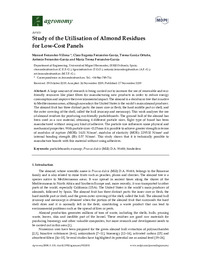Por favor, use este identificador para citar o enlazar este ítem:
https://hdl.handle.net/11000/34589Registro completo de metadatos
| Campo DC | Valor | Lengua/Idioma |
|---|---|---|
| dc.contributor.author | Ferrández-Villena, Manuel | - |
| dc.contributor.author | Ferrandez-Garcia, Clara Eugenia | - |
| dc.contributor.author | Garcia-Ortuño, Teresa | - |
| dc.contributor.author | Ferrández García, Antonio | - |
| dc.contributor.author | FERRÁNDEZ, MARÍA TERESA | - |
| dc.contributor.other | Departamentos de la UMH::Ingeniería | es_ES |
| dc.date.accessioned | 2025-01-16T17:38:07Z | - |
| dc.date.available | 2025-01-16T17:38:07Z | - |
| dc.date.created | 2019 | - |
| dc.identifier.citation | Agronomy | es_ES |
| dc.identifier.issn | 2073-4395 | - |
| dc.identifier.uri | https://hdl.handle.net/11000/34589 | - |
| dc.description.abstract | A large amount of research is being carried out to increase the use of renewable and ecofriendly resources like plant fibres for manufacturing new products in order to reduce energy consumption and improve their environmental impact. The almond is a deciduous tree that is native to Mediterranean areas, although nowadays the United States is the world’s main almond producer. The almond fruit has three distinct parts: the inner core or flesh, the hard middle part or shell, and the outer covering of the shell, called the hull (exocarp and mesocarp). This work analyses the use of almond residues for producing eco-friendly particleboards. The ground hull of the almond has been used as a raw material, obtaining 4 different particle sizes. Eight type of board has been manufactured without using any kind of adhesive. The particle size influences some physical and mechanical properties. With particle sizes <0.25 mm it is possible to achieve greater strength in terms of modulus of rupture (MOR): 14.01 N/mm2, modulus of elasticity (MOE): 2295.32 N/mm2 and internal bonding strength (IB): 0.57 N/mm2. This study shows that it is technically possible to manufacture boards with this material without using adhesives. | es_ES |
| dc.format | application/pdf | es_ES |
| dc.format.extent | 10 | es_ES |
| dc.language.iso | eng | es_ES |
| dc.publisher | MDPI | es_ES |
| dc.relation.ispartofseries | 9 | es_ES |
| dc.relation.ispartofseries | 12 | es_ES |
| dc.rights | info:eu-repo/semantics/openAccess | es_ES |
| dc.rights | Attribution-NonCommercial-NoDerivatives 4.0 Internacional | * |
| dc.rights.uri | http://creativecommons.org/licenses/by-nc-nd/4.0/ | * |
| dc.subject | particleboards | es_ES |
| dc.subject | exocarp | es_ES |
| dc.subject | Prunus dulcis (Mill) D.A. Webb | es_ES |
| dc.subject | binderless | es_ES |
| dc.subject.other | CDU::6 - Ciencias aplicadas::62 - Ingeniería. Tecnología | es_ES |
| dc.title | Study of the Utilisation of Almond Residues for Low-Cost Panels | es_ES |
| dc.type | info:eu-repo/semantics/article | es_ES |
| dc.relation.publisherversion | https://doi.org/10.3390/agronomy9120811 | es_ES |

Ver/Abrir:
2019.- Agronomy. Study of the Utilisation.pdf
419,89 kB
Adobe PDF
Compartir:
 La licencia se describe como: Atribución-NonComercial-NoDerivada 4.0 Internacional.
La licencia se describe como: Atribución-NonComercial-NoDerivada 4.0 Internacional.
.png)